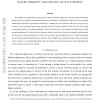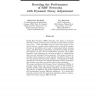58 search results - page 4 / 12 » A self-organising network that grows when required |
CORR
2008
Springer
13 years 8 months ago
2008
Springer
The problem of maximizing the average rate in a multicast network subject to a coverage constraint (minimum quality of service) is studied. Assuming the channel state information ...
IPPS
2000
IEEE
14 years 7 days ago
2000
IEEE
Time skewing is a compile-time optimization that can provide arbitrarily high cache hit rates for a class of iterative calculations, given a sufficient number of time steps and s...
SELMAS
2004
Springer
14 years 1 months ago
2004
Springer
The increased pervasiveness of mobile devices like cell phones, PDAs, and laptops draws attention to the need for coordination among these networked devices. The very nature of the...
NIPS
1994
13 years 9 months ago
1994
Radial Basis Function (RBF) Networks, also known as networks of locally{tuned processing units (see 6]) are well known for their ease of use. Most algorithms used to train these t...
IM
2003
13 years 9 months ago
2003
: Failed networks, for example MPLS, can cause signaling storms the size of which can grow dramatically with network size. This paper presents a new scalable fault notification pro...


